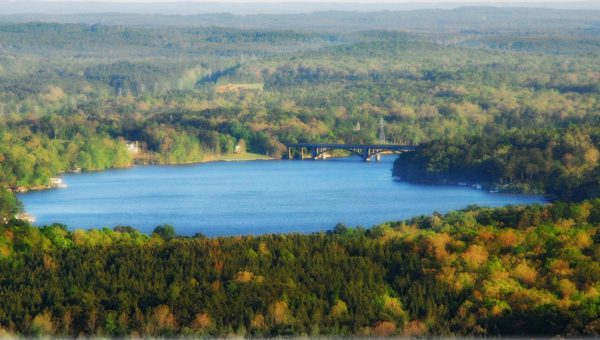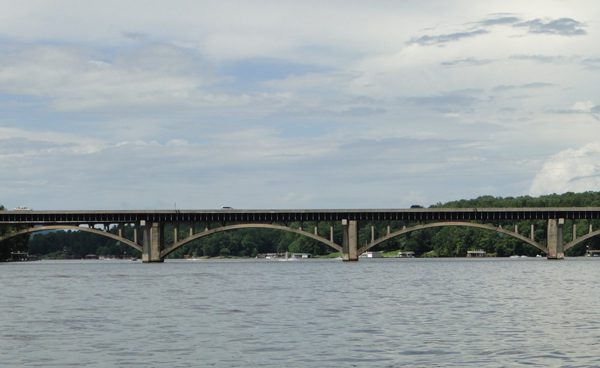Can public support save sturdy Swift Island Bridge?

One of the most harrowing experiences for a young driver in the Uwharries used to be crossing the Swift Island Bridge. For those of us east of the Pee Dee River, it was a dreaded necessity if we wanted to catch a movie in Albemarle. When I approached that seemingly endless span, with its narrow lanes and rush of oncoming traffic, I held my breath and gripped the steering wheel tighter. Today an adjacent bridge carries two lanes of eastbound traffic, and the Swift Island Bridge has been reconfigured into a single westbound lane. In the future, it could be reserved for pedestrians and cyclists instead of automobiles.
The N.C. Department of Transportation has proposed tearing down the Swift Island Bridge and replacing it with a modern structure, part of the plan to widen N.C. 24-27. This might be an expedient option, but people familiar with the bridge’s significance question its wisdom. Dating to 1927 and eligible for the National Register of Historic Places, the Swift Island Bridge is one of only five open-spandrel arch bridges left in the state.
It replaced a similar bridge built only five years earlier which was going to be flooded with the creation of Lake Tillery. Instead of simply demolishing that bridge, engineers seized the opportunity to test its strength. Enormous wooden tanks were built and filled with water. Each weighed 164 tons, many times the load the bridge was intended to bear. After rolling two across at once and producing only minor cracks in the concrete, engineers turned the bridge over to the U.S. War Department. Army airplanes peppered it with bombs. An artillery unit shelled it, then blasted it with mines. To the delight of engineers and the consternation of the military, it took an additional 2,000 pounds of dynamite to bring down the bridge. A film crew from the Metro-Goldwyn Picture Co. captured footage of what became known as “The Battle of Swift Island Bridge.” Click here to see the 16-minute video.
In June, the LandTrust for Central North Carolina board (Disclosure: I’m on that board) decided to take a leadership role in a growing effort to preserve the bridge. That might seem an odd mandate for a group devoted to land conservation, but we consider it a creative way to link protected tracts on either side of the river and make them more publicly accessible.
We first had to convince NCDOT to grant a 90-day extension before it decided the bridge’s fate. We now have until October to find an entity willing to take ownership of the bridge. The logical choice would be one of the counties on either side, but both Stanly and Montgomery have been reluctant to assume responsibility.
NCDOT is willing to give the new owner roughly $3 million, the cost of demolition minus the cost of bringing the bridge up to standards and adding bike and pedestrian facilities. his money, if invested conservatively by a group like the land trust instead of being restricted to bonds as the counties are required to do, would pay for insurance and maintenance.
Engineers have deemed the bridge structurally sound, so it shouldn’t need a great deal of expensive maintenance. If the previous bridge withstood the Army’s multifaceted assault, this one ought to be capable of carrying pedestrians and cyclists for many years to come, especially once vehicular traffic is removed and the roadway isn’t salted. The open-spandrel arch design is based on Roman bridges that have stood for two millennia.
The counties were also concerned that the extra expense incurred by NCDOT to fulfill this option – namely acquiring a new right-of-way corridor for another bridge – could jeopardize future funding for road projects in the region. However, the NCDOT funding formula has since changed, so that should no longer be a stumbling block.

Other cities across the nation have seen the benefits of preserving historic bridges for pedestrians and cyclists. One of the most successful has been the Walnut Street Bridge in Chattanooga. Built in 1890 and reopened in 1993, it has been instrumental in the resurgence of the city’s thriving Northshore District.
Unlike many other states’ transportation departments, NCDOT isn’t willing to keep title to a decommissioned historic bridge. That said, the agency has been supportive of pedestrian bridges, especially in urban areas. It covered most of the cost to build a visually stunning bridge over the I-440 beltline, helping the City of Raleigh extend its greenway system.
In the Uwharries, NCDOT has the opportunity to support a rural area struggling to capitalize on its natural resources and boost its tourist economy. At the land trust, we’d like to see a dedicated, protected lane for pedestrians and cyclists built as part of the N.C. 24-27 widening.
The connectivity could make for a compelling triathlon. I can imagine people coming from all over the country to swim from the Morrow Mountain State Park boat landing to the mouth of the Uwharrie River, then access trails for a run through the national forest, and finally pick up a bike at the trailhead and pedal back to the park.
This could sow the seeds for home-grown businesses to take advantage of the “traffic.” I envision a shop renting and repairing bikes. A bakery making biscuits filled with sausage and eggs from local farms. A café featuring seasonal produce. An ice cream shop using local peaches and berries. A brewpub serving thirst-quenching pints of “Uwharrie Gold.”
The Swift Island Bridge provides one of the best panoramas in the Uwharries – the view looking north toward Morrow Mountain State Park and the Uwharrie National Forest – and could become a destination unto itself. Replacing the Swift Island Bridge with a modern structure will simply speed people through our region; it won’t invite them to linger.
If the old bridge is torn down, the opportunity to create something special will be lost forever. The land trust board believes we should preserve this corridor between our region’s premier conservation lands – a link to our past, and to our future.
For a slideshow of images of the bridge by Deb Russell (who took the top photo in this article) click here.
Views expressed in this commentary are those of the author and do not necessarily represent the views of the UNC Charlotte Urban Institute or the University of North Carolina at Charlotte.
Views expressed in commentary articles here do not necessarily represent the views of the UNC Charlotte Urban Institute or the University of North Carolina at Charlotte. – See more at: http://plancharlotte.org/story/work-%E2%80%98hidden-profession%E2%80%99-all-around-you#sthash.2qSVet8D.dpuf Views expressed in commentary articles here do not necessarily represent the views of the UNC Charlotte Urban Institute or the University of North Carolina at Charlotte. – See more at: http://plancharlotte.org/story/work-%E2%80%98hidden-profession%E2%80%99-all-around-you#sthash.2qSVet8D.dpuf Views expressed in commentary articles here do not necessarily represent the views of the UNC Charlotte Urban Institute or the University of North Carolina at Charlotte. – See more at: http://plancharlotte.org/story/work-%E2%80%98hidden-profession%E2%80%99-all-around-you#sthash.2qSVet8D.dpuf Views expressed in commentary articles here do not necessarily represent the views of the UNC Charlotte Urban Institute or the University of North Carolina at Charlotte. – See more at: http://plancharlotte.org/story/work-%E2%80%98hidden-profession%E2%80%99-all-around-you#sthash.2qSVet8D.dpuf